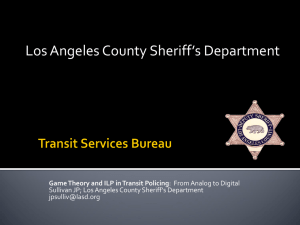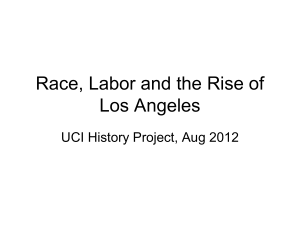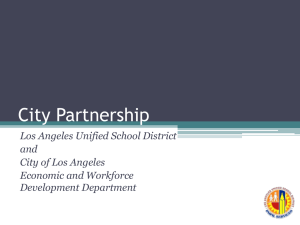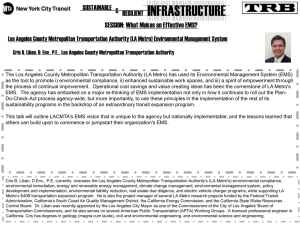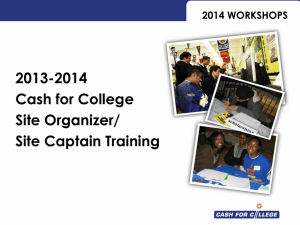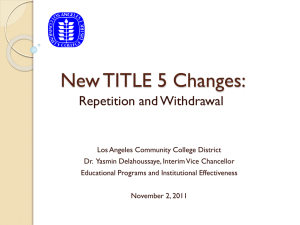2.4 Liban_LACMTA Ene.. - Trb
advertisement
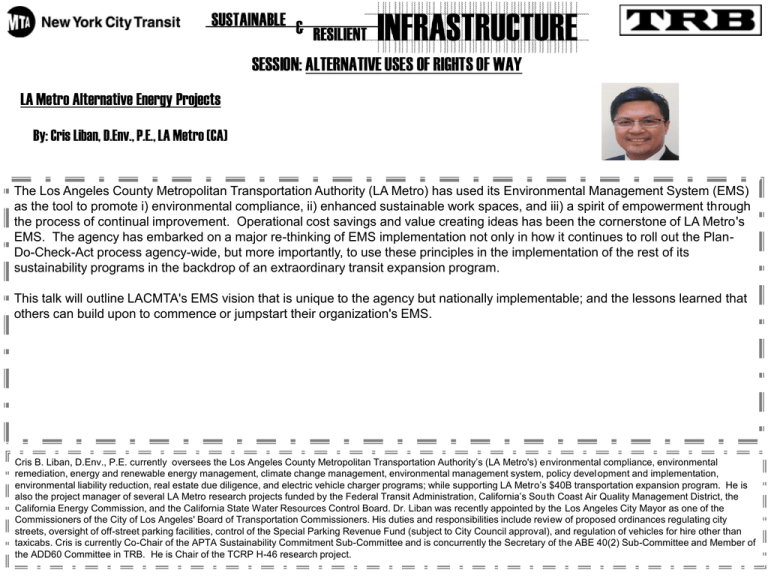
SESSION: ALTERNATIVE USES OF RIGHTS OF WAY LA Metro Alternative Energy Projects By: Cris Liban, D.Env., P.E., LA Metro (CA) The Los Angeles County Metropolitan Transportation Authority (LA Metro) has used its Environmental Management System (EMS) as the tool to promote i) environmental compliance, ii) enhanced sustainable work spaces, and iii) a spirit of empowerment through the process of continual improvement. Operational cost savings and value creating ideas has been the cornerstone of LA Metro's EMS. The agency has embarked on a major re-thinking of EMS implementation not only in how it continues to roll out the PlanDo-Check-Act process agency-wide, but more importantly, to use these principles in the implementation of the rest of its sustainability programs in the backdrop of an extraordinary transit expansion program. This talk will outline LACMTA's EMS vision that is unique to the agency but nationally implementable; and the lessons learned that others can build upon to commence or jumpstart their organization's EMS. Cris B. Liban, D.Env., P.E. currently oversees the Los Angeles County Metropolitan Transportation Authority’s (LA Metro's) environmental compliance, environmental remediation, energy and renewable energy management, climate change management, environmental management system, policy development and implementation, environmental liability reduction, real estate due diligence, and electric vehicle charger programs; while supporting LA Metro’s $40B transportation expansion program. He is also the project manager of several LA Metro research projects funded by the Federal Transit Administration, California’s South Coast Air Quality Management District, the California Energy Commission, and the California State Water Resources Control Board. Dr. Liban was recently appointed by the Los Angeles City Mayor as one of the Commissioners of the City of Los Angeles' Board of Transportation Commissioners. His duties and responsibilities include review of proposed ordinances regulating city streets, oversight of off-street parking facilities, control of the Special Parking Revenue Fund (subject to City Council approval), and regulation of vehicles for hire other than taxicabs. Cris is currently Co-Chair of the APTA Sustainability Commitment Sub-Committee and is concurrently the Secretary of the ABE 40(2) Sub-Committee and Member of the ADD60 Committee in TRB. He is Chair of the TCRP H-46 research project. Bold Steps to Meet an Energy Challenge 2014 TRB Sustainable and Resilient Infrastructure Workshop New York, NY Cris B. Liban, D.Env., P.E. Los Angeles County Metropolitan Transportation Authority June 17, 2014 Outline > > > > LA Metro Energy Needs Example Projects Emerging Issues/Reflections Questions/Discussion 3 LA Metro is Los Angeles County’s… Regional Transit Planner/Funder Regional Transit System Builder Regional Transit Operator 4 LA Metro‘s Challenges Reflects Overarching Needs What’s happening? What are we doing? Evolving regulatory climate and climate change issues Proactive operational activities to reduce impacts Increasing costs of operation and decreasing resource availability Create efficiencies, develop forecasting tools and implement innovative technologies Adapt large infrastructure projects (Measure R) to future climate impacts Transit schedule planning, mode selection, siting, alternatives, materials, and operational/maintenance changes. 5 An Integrated Approach 6 7 Foundations of Change > > > > > > > > > Environmental/Sustainability Policies Energy Conservation and Management Plan Climate Action and Adaptation Plan Annual Sustainability Reports Environmental Management System Environmental Training Institute Partnerships with Colleges and Universities Carbon Credit Initiatives Pilot Program Funding 8 Orange Line and Orange Line Extension Ventura County Los Angeles County San Bernardino County Orange Line and Extension Busway Opened in 2005, then 2012 CNG articulated buses LED lighting stoplights Solar panels along bikepath Sustainable Energy Features Los Angeles County Metropolitan Transportation Authority Orange County 9 Ventura County Gold Line Foothill Extension Los Angeles County San Bernardino County Gold Line Foothill Extension Light Rail Under Construction, opens 2015+ Green Maintenance Building Consider wastewater capture and infiltration Energy efficient stations Electric vehicle considerations Sustainable Energy Features Los Angeles County Metropolitan Transportation Authority Orange County 10 Red Line: Storage Flywheel Technology Junction of Red/Purple Line Ventura County Los Angeles County San Bernardino County Gold Line: Voltage Regulator Flywheel Technology Wayside Energy Storage Systems Los Angeles County Metropolitan Transportation Authority Orange County 11 Red Line: Storage MACE Between Universal/North Hollywood Ventura County Los Angeles County San Bernardino County Wind Tunnel Energy Pilot Los Angeles County Metropolitan Transportation Authority Orange County 12 Chatsworth Sun Valley Ventura County El Monte Station 213KW 213KW 500KW Downtown LA: CMF Los Angeles County San Bernardino County 1000KW Downtown LA: Div 13 ~1000KW Carson Solar Panel Installations Los Angeles County Metropolitan Transportation Authority 417KW Orange County 13 Green Buildings Division 9, El Monte Bauchet Street, LA > LEED Requirements > Five LEED-NC and Two LEED-EBOM > Future LEED-NC: Division 13/Expo/Foothill Extension > Future LEED-EBOM: D20/D7 Division 13, Downtown LA Metro Gateway HQ, LA El Monte Bus Station, El Monte 14 High Desert Corridor 15 High Desert Corridor PVs WESTERN SEGMENT CENTRAL SEGMENT EASTERN SEGMENT Solar Scenario Total Cost $88.4 M Total Gross Income $123.6 M Total Net Income $35.2 M Total kWh Average kWh per year Average Cost per kWh 1,073,000,000 35,800,000 $0.08236 An Integrated Approach Carbon Credits Administration (Green Fund) (06/2014) 17 Biomethane Strategy • Significantly increase renewable energy source • Environmental benefits • Reduced carbon footprint • No operational changes • Monetize carbon credits • O/M and sustainability capital funding • At par cost • Development incentives 18 Emerging Issues • • • • • • • Which comes first and why? PRIORITIES Lay out fundamentals: Policies, Plans, Specs Management/Frontline Support and Collaboration Long-term Capital Financial Strategies Partnerships: Benefit corporations Funding for pilot efforts Operations and Maintenance 19 Questions/Discussion Cris B. Liban, D.Env., P.E. p: 213/922-2471 c: 213/792-5777 e/m: LibanE@metro.net www.metro.net/ecsd 213/922-1100 sustainability@metro.net 20


